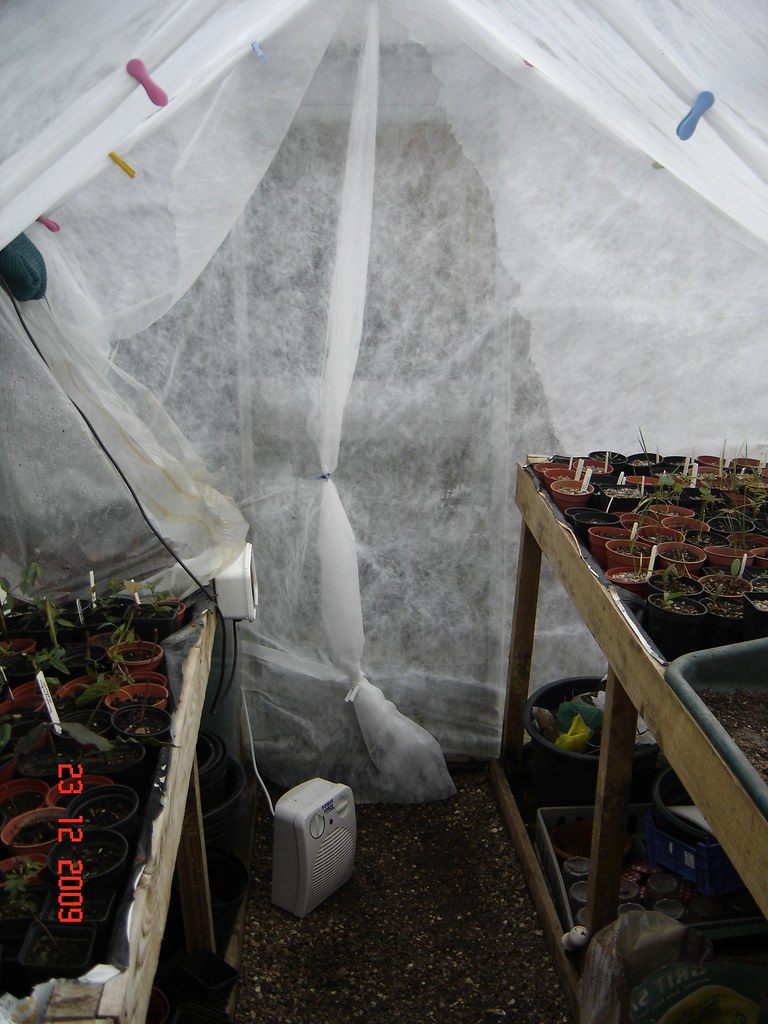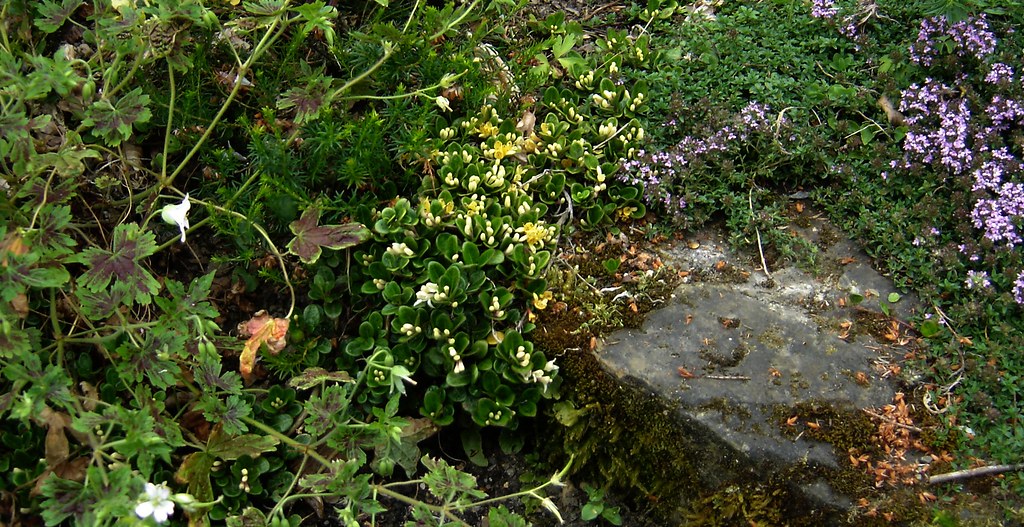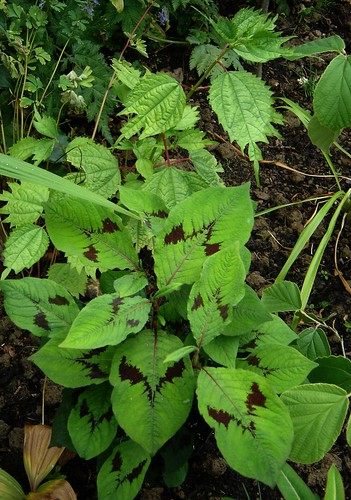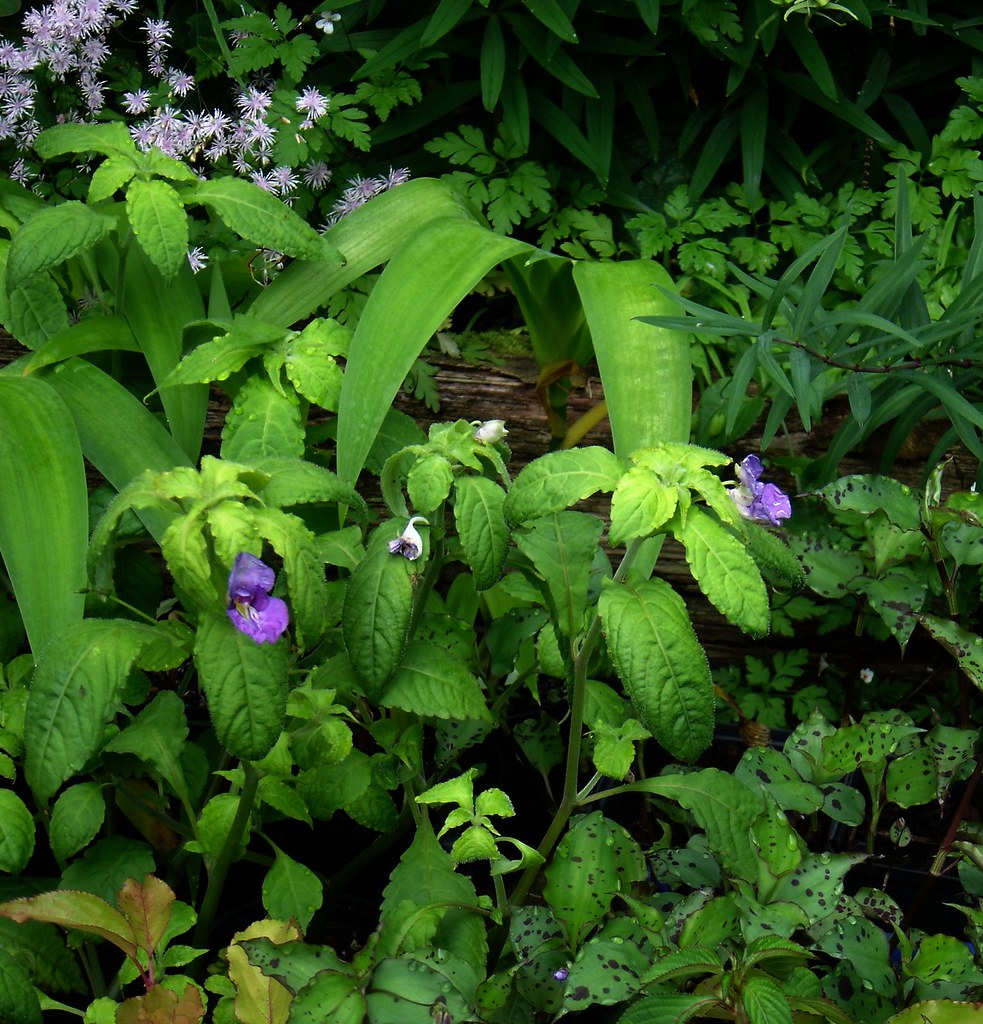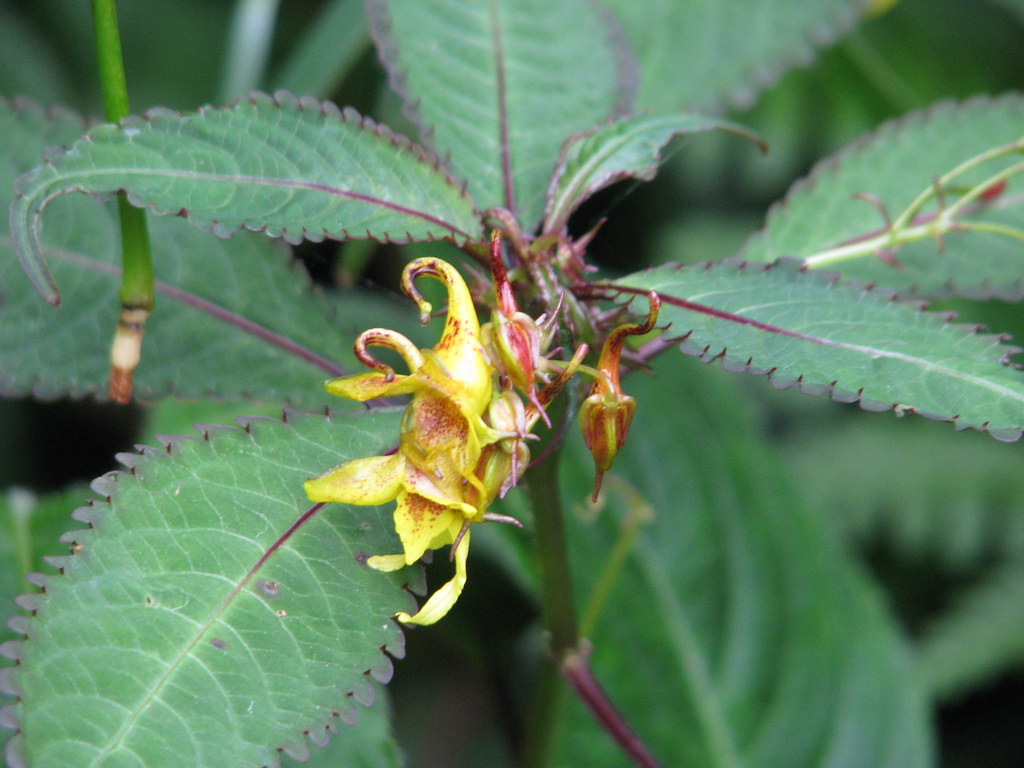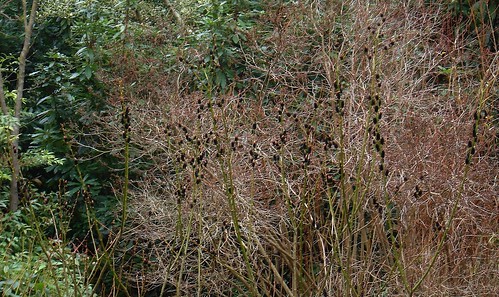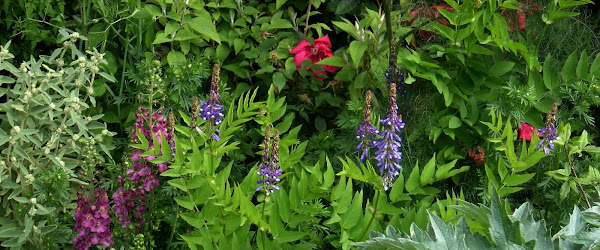Saturday, 19 December 2009
Fleeced
I seem to have erected a tent inside my greenhouse. I lost so many things that were supposed to be protected in the greenhouse last year that I've just lined the entire thing with fleece this year (and installed a fan-heater.)
There was the option of using bubble wrap but, besides being pricier, it also accumulates condensation and then drips, which can lead to botrytis (grey mould) on any dead, sick or weak vegetation.
Some plants from Mediterranean and subtropical climes, although potentially hardy enough might not be used to the kind of dank overcast conditions we get. If you keep them too warm they may try to grow, but without enough light and heat the new growth may be pale and weak and prone to moulds and aphids.
The fact is, winter protection of tender plants is always a balancing act between keeping just enough warmth in, not letting the air stagnate and providing as much light as possible.
There was the option of using bubble wrap but, besides being pricier, it also accumulates condensation and then drips, which can lead to botrytis (grey mould) on any dead, sick or weak vegetation.
Some plants from Mediterranean and subtropical climes, although potentially hardy enough might not be used to the kind of dank overcast conditions we get. If you keep them too warm they may try to grow, but without enough light and heat the new growth may be pale and weak and prone to moulds and aphids.
The fact is, winter protection of tender plants is always a balancing act between keeping just enough warmth in, not letting the air stagnate and providing as much light as possible.
Wednesday, 28 October 2009
Lonicera crassifolia
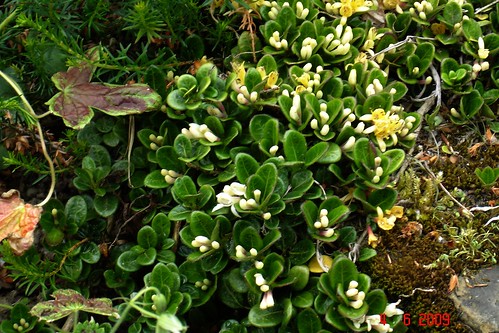
A lovely little evergreen creeping (not climbing) honeysuckle for ground cover or rockery. Possibly too vigorous for a trough but not rampageous. Just to give you a sense of the scale, that's an ordinary winter heather there at the top.
Another view of the same plant with heathers and thymes
1L pots ~ £8
Monday, 19 October 2009
Season of fruits and mellow mistfulness
I surprised myself this morning, strolling into town (to the dentist as it happens). It was wet and overcast and the leaves were really beginning to turn and fall, and I thought to myself what a relief it was that the summer was over. That's what surprised me. Normally I love the warm weather and tend to get a little depressed when it's over, but no, today I was positively buoyant.
The summer has been 'disappointing' they say, but then they say that every year. Normally I'd disagree but this year... What's it been? It's not been the rain - we've had something of a drought. Things have been looking quite sorry for themselves. Maybe it's been the sun. It's been dry, but it hasn't been bright, which is an unsatisfying state of affairs. This carried on until early October, by which time I was heartily sick of it. The cold and wet came as a welcome reprieve.
Actually I've known for a while I have a problem with August - memories of wet camping holidays as a child I expect. August is a con. It's not summer. August is the overture to autumn (as February is the overture to spring). You can feel it in the air. May and June are summer. I noted this year that things started to go off soon after the solstice. You might have noticed if you've been keeping up with the Emma's Garden photoset on Flickr that there's a lot fewer pictures from July to September than for other times. There's just nothing photogenic going on (unless you're into macro when you can look at the flowers in isolation and ignore the total ho-humness of everything around them.)
So now I look around at the garden and am once again filled with energy. Finally I can do something. As you'll know by now I'm not a fan of the well ordered neat-and-tidy sort of garden and I don't cut things down until I have to, but there's been a few things I've been looking at since July and inwardly groaning. It's my first full year here and I'm still very much learning how to grow things on this soil (clay, not much sun - the total opposite to gardening on the chalk near Lewes.) Things really have taken off here, especially in what I call the sunny border (it's all relative.) The Diascia personata especially has formed a huge engulfing mass, obscuring several less vigorous plants that I hope will still be there when I come to cut the Diascia back (or remove most of it actually.) Salvia uliginosa, which I thought would stand up straight behind and amongst it has flopped over on top of it, and the Helianthus atrorubens, also included for the tall dark wiry stems I imagined would stand tall behind that, has also fallen forward over everything. The problem is partly a red maple (bought as a standard tree some years back - it has never thrived), the fence behind and the path in front. Plants do not just passively fall over, they 'perceive' the path as an open space to grow into, and the tree and fence as shade and competition to grow away from. Hence they end up horizontal, getting trodden on. The mass of undergrowth was satisfying for a time - the Buddleia lindleyana held it's own well, the Eryngium giganteum elbowed its way up through the tangle, Gladiolus tristis shot up to 6ft high of so to get it's peculiar flowers into the light, like Diplodocus heads peering out of a thicket. But Rudbeckia maxima is under there somewhere, as are a couple of Dierama and two Decaisnea. I hope they'll recover. Kniphofia caulescens has definitely rotted off.
So anyway, perhaps you'll understand how, despite the fact that the Diascia and the Salvia are still blooming away, I'll be glad to get in there with the secateurs. The Diascia anyway I can honestly say I am thoroughly bored with. People always want to know about plants that just go on and on flowering all summer long, and if that's what you want I can heartily recommend it. You can have some of mine in fact (they're extremely easy from cuttings and totally hardy) but I'm sick of it. I like my season-long interest to come from the turn-over - things coming and going, changing places.
So that's one job. Whatever Diascia personata I keep will be further back, mixed in amongst everything else.
Then there's the huge Miscanthus in the middle of the border too. I can't wait for that to go over so I can have it out and do something better with that space. The maple will have to go too (it's had its chance) and the Lavatera Lilac Lady beside it. It's a good form - smaller that the commoner varieties and a nicer colour but not what I want now really. That'll leave a huge gap. I can't wait. Everything'll transpire a huge sigh of relief.
As for the rest of the garden - there's similar stories elsewhere. Mostly I'll leave the stems and old seed heads as long as I can - probably until January. I'll leave a stubble to discourage the dog from wandering about snapping off the new growths in spring. I'll make hazel 'bird-cages' for the Salvia and the Helianthus to grow through to support them through next summer. I've taken down the Bronze Fennel because I don't want too many of her offspring - lovely as she is.
People assume fallen leaves smother plants but except for small evergreens (lawns for example) that's rarely so, and the worms take them away and feed the soil in the process. People also like to cut things down as soon as possible after flowering - to get a second flush of flowers or make the plant put it's resources into the roots instead of the seed heads. I'm not sure either of these things make that much difference to most plants. I think it's more about neat and tidiness and I prefer the untidy textures and colours of autumn.
Which brings me back to my original point. When the dusty, listless scruffiness of August gave way to death's rich tapestry a couple of weeks back it was a release. Last 'summer' seemed interminable, but now, here we are, ready to move on again...
Monday, 28 September 2009
Persicaria virginiana and filiformis
Persicaria virginiana Compton's form
This American species is not that often offered, possibly because the flowers are quite small bright red filaments and appear in Autumn. A magnificent foliage plant though - as good as many of the tropical Calatheas and Marantas (prayer plants). The leaf surface has a real lustre - richly coloured and with an odd black chevron - I know not why.
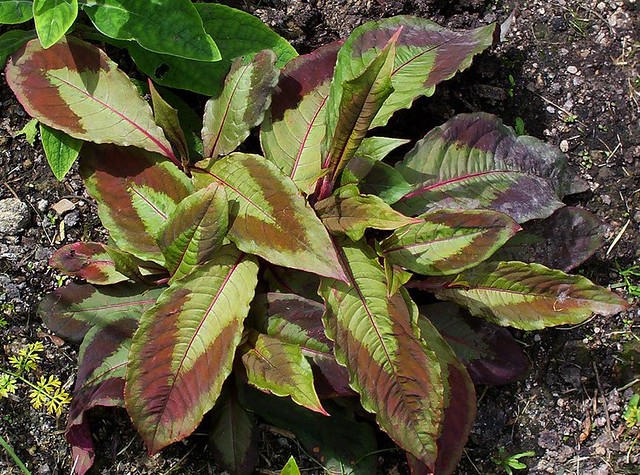
A good solid perennial for any soil in sun or semi shade. Height up to 4ft and not at all invasive.
£8
This American species is not that often offered, possibly because the flowers are quite small bright red filaments and appear in Autumn. A magnificent foliage plant though - as good as many of the tropical Calatheas and Marantas (prayer plants). The leaf surface has a real lustre - richly coloured and with an odd black chevron - I know not why.

A good solid perennial for any soil in sun or semi shade. Height up to 4ft and not at all invasive.
£8

The red filamentous inflorescences are produced earlier, in late summer/early autumn. It does seed about a little but in a good way. Very adaptable but best on moist soils
£8
Labels:
brighton,
Compton's form,
filiformis,
Guizhou,
nursery,
persicaria,
plants,
polygonum,
virginiana
Wednesday, 26 August 2009
Hardy Impatiens
I keep on telling people that these things are hardy but they don't really believe me. The look on their face says 'Yes but not really', and I say, no, they've all survived outdoors in the ground both here and on our heavy soil at home, and they still don't really believe it, but I can promise you. There is in fact a narrow shady raised bed at the nursery only 6ins deep over the Mypex where three of them - arguta, uniflora and puberula are in danger of taking over. They even seem to do quite well in dry shade under shrubs. Almost too good to be true.
People are always wanting plants for shady places that flower on and on all summer. Well here they are. Come and get them...
Impatiens arguta, originally uploaded by peganum.
Impatiens argutaPeople are always wanting plants for shady places that flower on and on all summer. Well here they are. Come and get them...
Impatiens arguta, originally uploaded by peganum.

The most reliable hardy species here in Sussex - even in dry shade. A vigorous species with large tubular purple flowers on red stems. Ideal for any shady situation and flowering all summer.
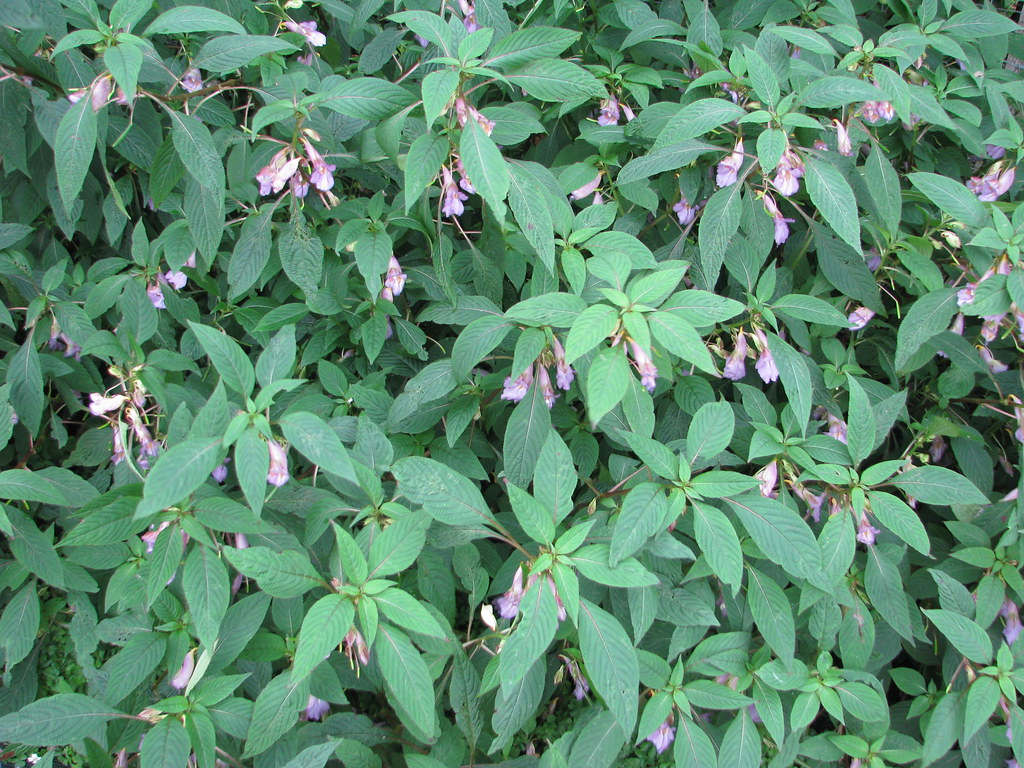
A large plant in the border at the nursery in late October. What's not to like?
1L pots ~ £8
Impatiens puberula
Another hardy purple flowered species, this time with soft green, somewhat fuzzy foliage. The flowers are more chubby with dark purple lips and a paler 'bag' behind, if you see what I mean.
Needs the same conditions as arguta but is more spreading as the stems root where they touch the ground.
£6
Impatiens stenantha
£6
Impatiens stenantha
Caryopteris divaricata
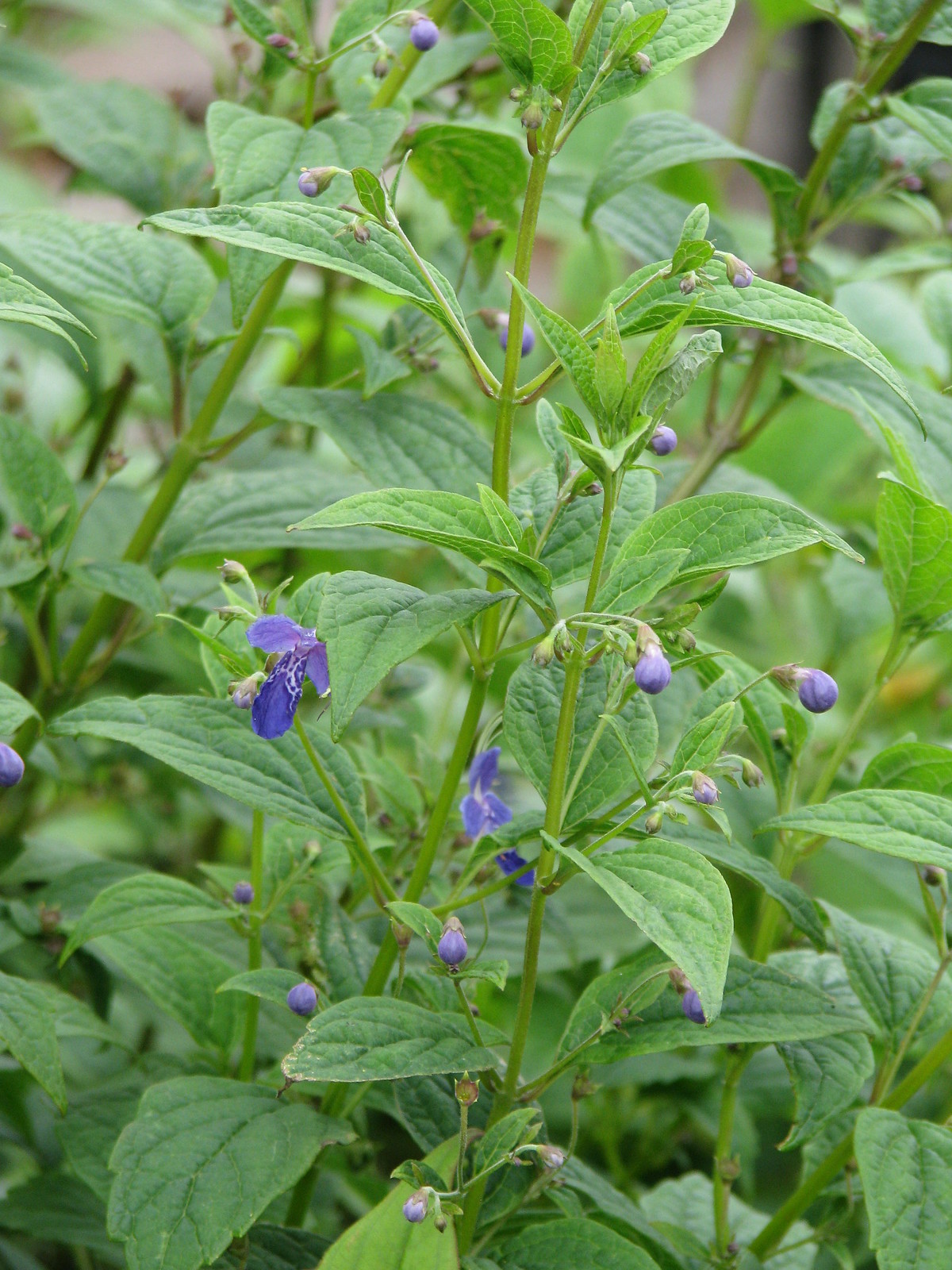
The name Caryopteris is usually associated with a bunch of rather grey twiggy subshrubs grown mainly because they flower very late in the season (C. x clandonensis and the like). C.divaricata is very different - making a lush green upright bush and dying down completely in winter. The late flowering is the same but the flowers themselves are much more interesting as can be seen from the photo. Those of you who know the tropical Clerodendron (or Rotheca) myricoides (or ugandense) would be right in thinking they look suspiciously similar, with those long curling filaments and rounded purple blue petals. They are related.
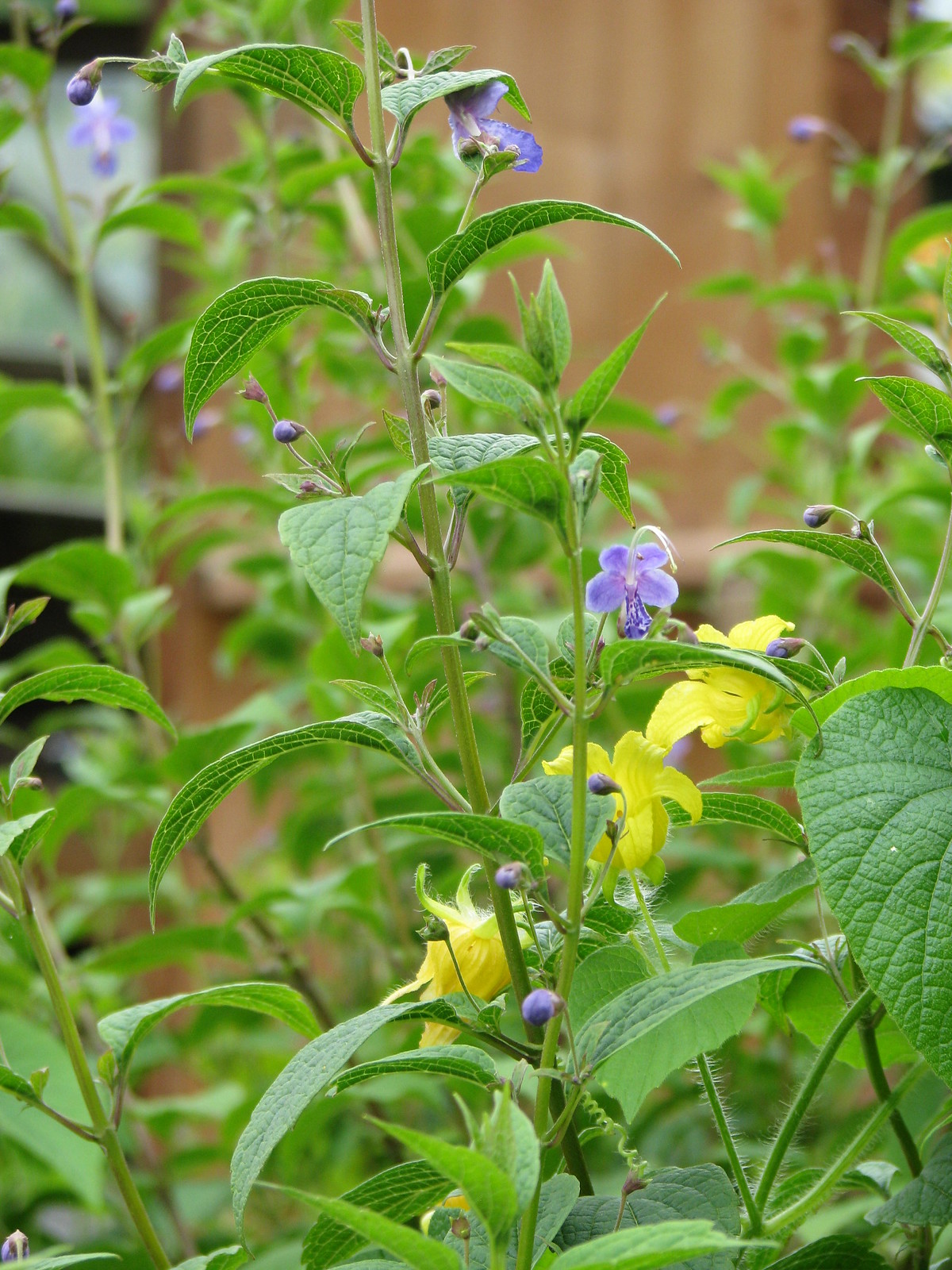
Another well-known purveyor of rare plants describes the flowers as merely ‘harmless’ which I think is a bit unfair. They’re not huge or especially plentiful, but they are beautifully crafted and jolly pretty. The only down side is the foliage which has an odd odour (one customer calls it The OXO plant) so don't plant it too near the path unless you like that sort of thing. Also the stems are quite brittle so best planted amongst other things out of the wind.
3L pots ~ £8
Saturday, 15 August 2009
Salix gracilistyla melanostachys
A very wacky willow for you, this time grown for it's bituminous black catkins in early spring which sprout pale yellow anthers and have red highlights.
It's hard to get a good shot of this from a distance with any 'interference' in the background, but the black catkins, (see photo below) are striking. Potentially a large shrub but responds well to quite hard pruning immediately after flowering.

Specimen size plants - £30 - collection only
It's hard to get a good shot of this from a distance with any 'interference' in the background, but the black catkins, (see photo below) are striking. Potentially a large shrub but responds well to quite hard pruning immediately after flowering.

Specimen size plants - £30 - collection only
Labels:
brighton,
gracilistyla,
melanostachys,
nursery,
plants,
salix
Saturday, 8 August 2009
Senna hebecarpa
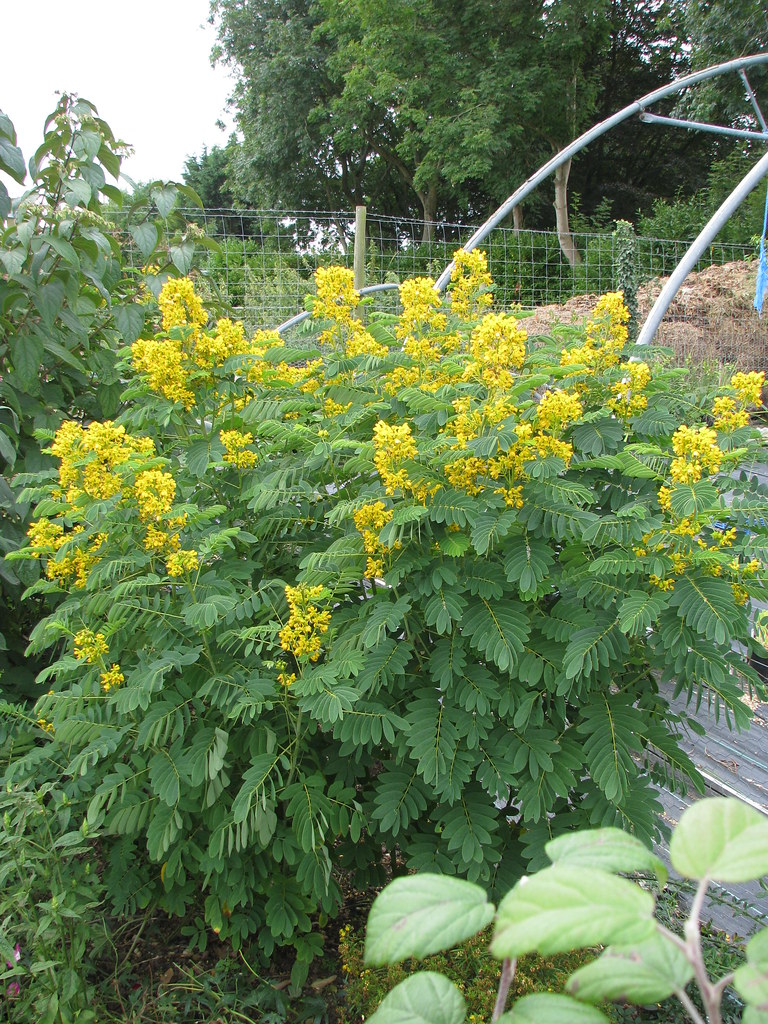
I'm not sure why the North American Sennas are not better known in the UK. I know two of them reasonably well - hebecarpa and marilandica (both sometimes included in Cassia.) The former seems to be the better of the two. They're big exotic looking plants but completely hardy given their distribution as far north as the Great Lakes.
The foliage is lush and the flowers give a good show in the latter part of the summer.

Ideal for prairie type plantings with other native Americans (so to speak) they grow well in moist rich soils in full sun but should tolerate some shade and drought.
3L pots ~ £10
Saturday, 1 August 2009
Tinantia pringlei
A hardy Mexican relative of the popular houseplant Tradescantias. It dies back completely in winter but comes back strongly from the roots in spring forming a dense ground-cover. The foliage is black spotted (not diseased) and there is a succession of the little three-petalled mauve flowers through the summer.
Completely hardy through the last few winters here in Sussex, and in fact inclined to turn up in unexpected places around the garden.
Thank you so much.
Completely hardy through the last few winters here in Sussex, and in fact inclined to turn up in unexpected places around the garden.
clumps lifted from the ground - £5
Please please please, may I humbly request that you check with me that the plants you require are in stock before you order? Otherwise we'll have to arrange refunds.
Please please please, may I humbly request that you check with me that the plants you require are in stock before you order? Otherwise we'll have to arrange refunds.
Thank you so much.
Sunday, 26 July 2009
Mediterranean and Sub-tropical
A couple of years back I was very excited to read the catalogue of a nursery called Koba Koba, based somewhere down in Devon. (I just checked - they've closed apparently.) I was excited because they were offering a substantial list of 'hardy' gingers and other 'hardy' subtropical plants such as Musa (bananas) and Amorphophallus (those extraordinary giant Arums that stink of rotting meat) and at the time I was very drawn to the whole 'hardy exotics'/'architectural plants' thing. The plants they offered had always interested me but like most gardeners in the UK, I'd thought of them only as specimens for tropical greenhouses and conservatories. A book on the subject (Hardy Gingers by T.M.E.Branney, Timber Press) came out and I duly obtained my copy.
I was aware that some genera in the family (Hedychium, Roscoea, Cautleya) included some good hardy species but was astounded by the variety of what I had previously considered truly tropical groups (Zingiber, Alpinia, Costus, Kaempferia and Curcuma for example) that could tolerate apparently much lower temperatures than we have experienced in this part of the world for many years (-12C for Alpinia zerumbet, -15C for Costus speciosus for example). I couldn't wait to try some.
What was not apparent until I got over my euphoria was that these temperatures are only tolerated if the roots are kept completely dry in the winter.
I'll let that sink in for a moment...
That's completely dry. In the winter... In the UK...
Clearly someone has a funny idea what 'hardy' means but I hesitate to say that they were deliberately misleading us in order to sell plants (or books) but I have a more interesting point to make here because this was the first time in my 20 years gardening career that I had genuinely understood the importance of climate in gardening beyond merely taking into account a plant's tolerance of cold.
What we perhaps forget, living in the UK where it seems to rain more or less equally all year round, is that in many parts of the world, and not just the tropics, there is a definite wet and dry season. We in Northern Europe actually live in a winter wet part of the world. It doesn't seem like it much of the time because Britain has a maritime climate (remember your high school geography) which is never dry for long, but travelling due east, across Europe and into Central Asia it becomes increasingly obvious how much of the year's rain (or snow) falls in the Autumn-Spring period, and, saving a few thunder storms, how little falls in the summer. The difference is striking even between Devon and Essex if you look at the statistics. The Mediterranean area is, as I understand it, just the southern limit of this temperate winter rainfall zone, where summer heat is high enough to cause enough evaporation to create a semi-desert environment. The amount of rainfall annually is not that different to northern Europe.
Similar environments (known as 'Mediterranean' for short) can be found wherever similar situations occur all over the world, where the temperate winter rainfall zone slips equatorwards along the west coast - in California, parts of northern Chile, the Western Cape of South Africa, and the southern corner of West Australia. These regions are unusually harsh environments - the hot and dry seasons coinciding means that most plants are active in the winter and dormant during the summer (spring bulbs for example.)
A lot of plants from these areas will not tolerate freezing (although a surprising number will - at least to -5C) but generally, 'Mediterranean' plants are relatively easy to grow in the UK because we have something like the same climate, with relatively dry summers. As long as the plants are grown in the sunniest spot available and the soil drains very freely they can be extraordinarily hardy. They're especially useful in situations that become completely parched in summer - on chalk and sand soils for example, and up against south and east-facing walls. They also tolerate the drying effects of hedge and tree roots as long as they will also tolerate some shade.
Not so for plants from summer rainfall areas. Mediterranean climate areas cover a very small part of the world but summer rainfall is normal over almost all of the rest of world's land surface. We are used to hearing about the hurricane season in the USA and the Monsoon in India or Thailand, but it's much the same throughout southern and eastern Asia, eastern and northern Australia, much of South America and almost all of Africa. The only exceptions are the equatorial tropics where the rain falls all year round and where the rainforest dominates (or used to) and the zones between the winter wet Mediterranean areas and the summer wet subtropical areas where almost no rain falls at all. This is where the major deserts form.
Much of this area is far too tropical to provide plants for our British gardens but where the summer rainfall zone slips polewards along the east coast it takes in parts of temperate Eastern Asia, south eastern Australia and New Zealand, a small part of south eastern Africa, parts of South America and a large slice of southern USA and Mexico. In these areas the winter temperatures can be similar to those we get here, but without the wet.
So were the 'hardy gingers' a bit of a scam? Well, maybe. But summer rainfall plants aren't as useless as you might think. Many of them come from remarkably cold parts of the world. The deserts of North America extend all the way into Canada and provide us with some incredibly frost tolerant cacti and Agave. Even plants from as far south as Arizona and New Mexico, Alabama and Georgia may suffer much harder winters than we do. Plants from Patagonia and parts of central China are in a similar position. The Eastern Australians and Africans are generally less frost tolerant but especially if they come from upland areas, they can be amazingly adaptable too. The Agapanthus, Kniphofia, Phygelius, Galtonia and Crocosmia we grow come from the highlands of east Africa. The area from southern Brazil to northern Argentina gives us many good garden Salvias (uliginosa, guaranitica, involucrata), Passiflora caerulea, Abutilon megapotamicum and Gunnera manicata. Australia is less generous but this may have more to do with the quality of the soil than the climate. I have kept Banksias, Correas, Lomatias and Grevilleas from New South Wales outdoors all year round in pots for the last fifteen years, and lost none except a Correa I planted out last year. The trick is to keep them as dry at the root as possible - it is commonly believed that any plant of doubtful hardiness will be better off in the ground as the soil will insulate the roots but this is not necessarily the case. Potted plants dry out quickly, especially if somewhat root bound. Thus it helps if your 'subtropical' plants are drought tolerant desert dwellers.
The problem then with the 'hardy gingers' mentioned above is that, during the growing season they are not at all drought tolerant. Alpinia, Costus and Curcuma are woodlanders and need moist, rich, even wet soil during the summer, as do the Amorphophallus. I can't think of any way of arranging the wet summer/dry winter regime these plants need in the open garden in the UK unless it's by lifting them in the winter and storing them like Dahlias (which are of course the classic winter rainfall plant). Not all plants put up with this sort of disturbance.
One final point I must add. Along with the wet summer many of these plants require, is a need for heat and light during the growing season that is often hard to provide in the UK. Plants from the southern states of the USA for example may experience freezes like nothing we see here, but the summers are long and hot and, in between storms, bright and sunny. An extraordinary plant like Hibiscus coccineus is totally frost hardy but may not come into growth early enough to flower before the autumn frosts cut it back down again. Some Hedychium have similar problems. If we want to grow these fabulous plants we may have to borrow some tricks from the vegetable growers - using black plastic to heat the soil up early for example. They'll need siting in the hottest possible situation and yet in a spot that is moist and fertile. A west facing wall may help.
On the other hand, in the deserts of Australia and Arizona for example, a bitterly cold winter night is typically followed by a bright dry winter day. A south or east facing wall or similar is our best hope for these plants.
Finally, woodlanders from the monsoon zones of southern and eastern Asia (Tricyrtis, Arisaema, Calanthe, Anemonopsis, Deinanthe, Asarum etc etc) do not tolerate the dry summers we have in eastern England at all well, exacerbated as it is by trees, sucking up every last drop of moisture. They will enjoy a dank north-facing exposure and a woodsy soil without nearby trees rooting into it.
Ok, that's more than enough for now. You will have noticed that I don't feel the need to write my blog in little twitterish 'sound-bites' as seems fashionable, and actually, I really like the old essay form, or a good solid article in a 'proper' journal. I hope you have the stamina and find it worthwhile.
I was aware that some genera in the family (Hedychium, Roscoea, Cautleya) included some good hardy species but was astounded by the variety of what I had previously considered truly tropical groups (Zingiber, Alpinia, Costus, Kaempferia and Curcuma for example) that could tolerate apparently much lower temperatures than we have experienced in this part of the world for many years (-12C for Alpinia zerumbet, -15C for Costus speciosus for example). I couldn't wait to try some.
What was not apparent until I got over my euphoria was that these temperatures are only tolerated if the roots are kept completely dry in the winter.
I'll let that sink in for a moment...
That's completely dry. In the winter... In the UK...
Clearly someone has a funny idea what 'hardy' means but I hesitate to say that they were deliberately misleading us in order to sell plants (or books) but I have a more interesting point to make here because this was the first time in my 20 years gardening career that I had genuinely understood the importance of climate in gardening beyond merely taking into account a plant's tolerance of cold.
What we perhaps forget, living in the UK where it seems to rain more or less equally all year round, is that in many parts of the world, and not just the tropics, there is a definite wet and dry season. We in Northern Europe actually live in a winter wet part of the world. It doesn't seem like it much of the time because Britain has a maritime climate (remember your high school geography) which is never dry for long, but travelling due east, across Europe and into Central Asia it becomes increasingly obvious how much of the year's rain (or snow) falls in the Autumn-Spring period, and, saving a few thunder storms, how little falls in the summer. The difference is striking even between Devon and Essex if you look at the statistics. The Mediterranean area is, as I understand it, just the southern limit of this temperate winter rainfall zone, where summer heat is high enough to cause enough evaporation to create a semi-desert environment. The amount of rainfall annually is not that different to northern Europe.
Similar environments (known as 'Mediterranean' for short) can be found wherever similar situations occur all over the world, where the temperate winter rainfall zone slips equatorwards along the west coast - in California, parts of northern Chile, the Western Cape of South Africa, and the southern corner of West Australia. These regions are unusually harsh environments - the hot and dry seasons coinciding means that most plants are active in the winter and dormant during the summer (spring bulbs for example.)
A lot of plants from these areas will not tolerate freezing (although a surprising number will - at least to -5C) but generally, 'Mediterranean' plants are relatively easy to grow in the UK because we have something like the same climate, with relatively dry summers. As long as the plants are grown in the sunniest spot available and the soil drains very freely they can be extraordinarily hardy. They're especially useful in situations that become completely parched in summer - on chalk and sand soils for example, and up against south and east-facing walls. They also tolerate the drying effects of hedge and tree roots as long as they will also tolerate some shade.
Not so for plants from summer rainfall areas. Mediterranean climate areas cover a very small part of the world but summer rainfall is normal over almost all of the rest of world's land surface. We are used to hearing about the hurricane season in the USA and the Monsoon in India or Thailand, but it's much the same throughout southern and eastern Asia, eastern and northern Australia, much of South America and almost all of Africa. The only exceptions are the equatorial tropics where the rain falls all year round and where the rainforest dominates (or used to) and the zones between the winter wet Mediterranean areas and the summer wet subtropical areas where almost no rain falls at all. This is where the major deserts form.
Much of this area is far too tropical to provide plants for our British gardens but where the summer rainfall zone slips polewards along the east coast it takes in parts of temperate Eastern Asia, south eastern Australia and New Zealand, a small part of south eastern Africa, parts of South America and a large slice of southern USA and Mexico. In these areas the winter temperatures can be similar to those we get here, but without the wet.
So were the 'hardy gingers' a bit of a scam? Well, maybe. But summer rainfall plants aren't as useless as you might think. Many of them come from remarkably cold parts of the world. The deserts of North America extend all the way into Canada and provide us with some incredibly frost tolerant cacti and Agave. Even plants from as far south as Arizona and New Mexico, Alabama and Georgia may suffer much harder winters than we do. Plants from Patagonia and parts of central China are in a similar position. The Eastern Australians and Africans are generally less frost tolerant but especially if they come from upland areas, they can be amazingly adaptable too. The Agapanthus, Kniphofia, Phygelius, Galtonia and Crocosmia we grow come from the highlands of east Africa. The area from southern Brazil to northern Argentina gives us many good garden Salvias (uliginosa, guaranitica, involucrata), Passiflora caerulea, Abutilon megapotamicum and Gunnera manicata. Australia is less generous but this may have more to do with the quality of the soil than the climate. I have kept Banksias, Correas, Lomatias and Grevilleas from New South Wales outdoors all year round in pots for the last fifteen years, and lost none except a Correa I planted out last year. The trick is to keep them as dry at the root as possible - it is commonly believed that any plant of doubtful hardiness will be better off in the ground as the soil will insulate the roots but this is not necessarily the case. Potted plants dry out quickly, especially if somewhat root bound. Thus it helps if your 'subtropical' plants are drought tolerant desert dwellers.
The problem then with the 'hardy gingers' mentioned above is that, during the growing season they are not at all drought tolerant. Alpinia, Costus and Curcuma are woodlanders and need moist, rich, even wet soil during the summer, as do the Amorphophallus. I can't think of any way of arranging the wet summer/dry winter regime these plants need in the open garden in the UK unless it's by lifting them in the winter and storing them like Dahlias (which are of course the classic winter rainfall plant). Not all plants put up with this sort of disturbance.
One final point I must add. Along with the wet summer many of these plants require, is a need for heat and light during the growing season that is often hard to provide in the UK. Plants from the southern states of the USA for example may experience freezes like nothing we see here, but the summers are long and hot and, in between storms, bright and sunny. An extraordinary plant like Hibiscus coccineus is totally frost hardy but may not come into growth early enough to flower before the autumn frosts cut it back down again. Some Hedychium have similar problems. If we want to grow these fabulous plants we may have to borrow some tricks from the vegetable growers - using black plastic to heat the soil up early for example. They'll need siting in the hottest possible situation and yet in a spot that is moist and fertile. A west facing wall may help.
On the other hand, in the deserts of Australia and Arizona for example, a bitterly cold winter night is typically followed by a bright dry winter day. A south or east facing wall or similar is our best hope for these plants.
Finally, woodlanders from the monsoon zones of southern and eastern Asia (Tricyrtis, Arisaema, Calanthe, Anemonopsis, Deinanthe, Asarum etc etc) do not tolerate the dry summers we have in eastern England at all well, exacerbated as it is by trees, sucking up every last drop of moisture. They will enjoy a dank north-facing exposure and a woodsy soil without nearby trees rooting into it.
Ok, that's more than enough for now. You will have noticed that I don't feel the need to write my blog in little twitterish 'sound-bites' as seems fashionable, and actually, I really like the old essay form, or a good solid article in a 'proper' journal. I hope you have the stamina and find it worthwhile.
Friday, 10 July 2009
Hydrangea serrata Kiyosumi

A typical lacecap Hydrangea in many ways but with two unusual features - the sterile florets around the edge of the inflorescence are white, edged with pink (but tastefully so), and the new foliage is a rich maroon red.
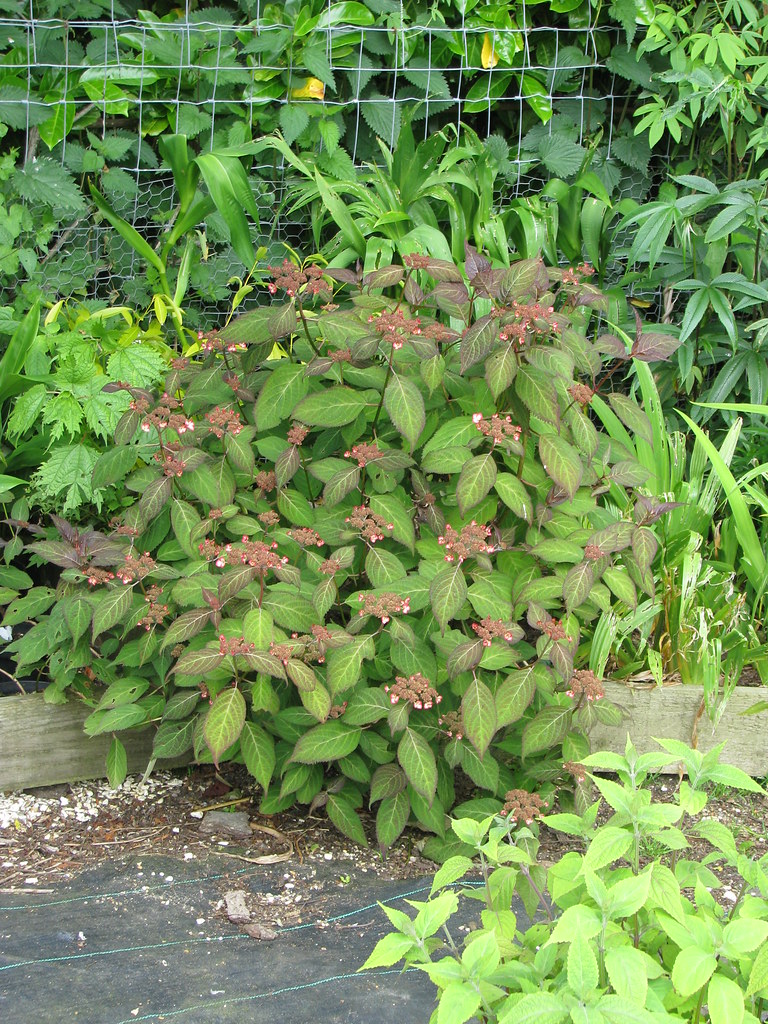
A striking small shrub (about 4ft high) for semi-shade on most soils as long as not too dry (including chalk. Hydrangeas are among those plants often believed to be lime-haters. This is not the case.)
2L pots ~ £9
Saturday, 4 July 2009
Scientific names or not, as the case may be
I was thinking my blog list was looking a bit empty today (Hi Paul!) and so thought I'd have a look around at what sorts of things other gardener's blogs are on about. After a quick look, I've not come across anything like this one - most seem to be either about growing veg or conservation (and good for them). We're all about growing something unusual just for the sheer hell of it here. It doesn't have to be useful. It doesn't have to be especially rare. It just has to be something interesting that you don't see every day. Hopefully we'll fill a niche.
I came across this on Garden Rant (excellent name by the way - I love a good rant) about the use of scientific names. There's a long discussion pro and con there if you're interested. It's an issue I come across from time to time and you'll have noticed I use them all the time.
Most people I deal with seem to accept it - they too are plant fanatics and take the names for granted. Other people I speak to though - non gardeners and people who 'just want their yard to look nice' can seem a bit bemused. Most of the time I just tend to say "well just come and have a look and see what appeals to you and I'll give you some advice on you how to grow it" and they seem happy with that. After all, you don't need to understand your boiler to get hot water. A small minority though do seem to see my use of the latin as in some way elitist, snobbish, exclusive. (It's not really latin of course, scientific names are not only cobbled together from latin and classical greek but also incorporate modern people and place names and even local 'common' names as in the Japanese Kirengeshoma.) Interestingly, it's not the non-gardeners who tend to feel this way but rather, people who've been gardening for years and never seen the need. They can be very put out indeed.
So, scientific names. Why? Firstly - there's a time and a place. If I was concentrating on growing local native species for conservation for example I'd use the local vernacular. Likewise if I was growing fruit and veg or a very traditional garden of historically important herbs and flowers no doubt I'd stick to the perfectly good common names. I wouldn't say "I'm just going out to trim the Taxus baccata" or "How many Daucus carota do you want?"
But a quick look through even my modest catalogue makes it pretty obvious that this method breaks down in the face of the sheer quantity of plants from all over the world on offer these days. What would these 'traditionalists' prefer me to call Weigela middendorfiana? Middendorf's weigela? One suggestion was 'The Yellow Weigela', which was interesting on two counts. Firstly it's not the only yellow Weigela. Secondly of course, Weigela is a scientific name (commemorating someone called Weigel presumably). What a lot of traditionalists seem to forget is that many of the names they take for granted are scientific names - Rhododendron, Forsythia, Hydrangea, Delphinium, Geranium... and frankly, if you can wrap your tongue around Chrysanthemum you can handle pretty much anything. The biggest difficulty I find is when the name commemorates a Russian - take Molly-the-Witch as she is affectionately known among the tongue-tied (Paeonia mlokosewitschii). Or what about Ligularia przewalskii?
There's a certain amount of verbal contortionism involved here. The Ligularias used to be classified in Senecio - home of ragworts and groundsels. Siberian ragwort? Well actually there's a lot of Ligularias from that part of the world. I wonder what the locals call it, whoever they are? And then I wonder if we could pronounce it?
Some scientific names are claimed to be descriptive, so a simple translation should be possible. (The spider plant is my favourite - Chlorophytum. It means 'green plant'. How helpful is that?)
Let me think of a good one...
Ok, Hedge-garlic-leaved bell-flower. How's that? Easier than Campanula alliarifolia? It is fairly descriptive as these things go but there are several species fitting that description. You'd have to add 'pink' to the front perhaps to distinguish it from the very similar C.makaschvillii, and maybe other descriptions to avoid confusion with C.ochroleuca which is very similar. This is one of the problems - many gardeners just don't realise how many species there are out there. To those of us who only frequent garden centres it might appear that Campanula alliarifolia and Weigela middendorfiana are pretty unusual for their kind, but unfortunately they're not. They each belong in a group of similar species. Perhaps the traditionalists would not bother to make the distinction, and sometimes to all intents and purposes it doesn't matter that much.
How much it does matter really depends on how well the botanists have done their job. If they've simply been out there in the hills, giving new names to things that really aren't new, just to get their name on a scientific paper (as some gardeners suspect) then we are right to to ignore them. On the other hand, unfortunately, the criteria on which the botanists identify a new plant are often beyond the expertise of the average gardener or even other scientists. We have to take their word for it a lot of the time. And this unfortunately is the main point. Plant nomenclature is borrowed from the scientists. They do things differently. There is nothing to stop us as gardeners setting up our own horticultural nomenclature if we so wish. To some extent we already do - we classify plants according to whether they are edible or not, what colour the flowers are, whether they are hardy or not. The regulations on the use of cultivar names (the names of forms and hybrids of plants not found in the wild but originating in cultivation) are amazingly strict and often infuriating to gardeners (and the results can be cringingly unimaginative - how many Golden Queens and Blue Fountains and Ruby Dwarfs do we need?) But again, the number of types available is easy to underestimate and some form of system is needed if you're at all choosy about which one you want. You can't just ask for a damask rose or a lavender and be sure of getting the same thing you saw in that garden in Cornwall. You need to know the name, and it probably won't matter whether you are looking for Mme Zoetmans (how descriptive is that?) or Lavandula stoechas.
Which brings me, at last, to my final point - that actually the scientific names can, once you get the hang of them, be every bit as easy to say and to remember as the vernacular, and can be as evocative. I'm not sure anyone knows for sure how Latin should be pronounced, and as I said, it isn't strictly latin anyway, so, if in doubt, as with Spanish and Italian I tend to say the names phonetically. The references to people and places can be pronounced however the people and places are normally pronounced and as for the rest, well, my best advice is don't rush at it. Like being back at school, look at the word, take it apart, say the parts, get used to what they sound like in your mouth, and say it with confidence - Kirengeshoma!
Now people's names - they are a problem...
I came across this on Garden Rant (excellent name by the way - I love a good rant) about the use of scientific names. There's a long discussion pro and con there if you're interested. It's an issue I come across from time to time and you'll have noticed I use them all the time.
Most people I deal with seem to accept it - they too are plant fanatics and take the names for granted. Other people I speak to though - non gardeners and people who 'just want their yard to look nice' can seem a bit bemused. Most of the time I just tend to say "well just come and have a look and see what appeals to you and I'll give you some advice on you how to grow it" and they seem happy with that. After all, you don't need to understand your boiler to get hot water. A small minority though do seem to see my use of the latin as in some way elitist, snobbish, exclusive. (It's not really latin of course, scientific names are not only cobbled together from latin and classical greek but also incorporate modern people and place names and even local 'common' names as in the Japanese Kirengeshoma.) Interestingly, it's not the non-gardeners who tend to feel this way but rather, people who've been gardening for years and never seen the need. They can be very put out indeed.
So, scientific names. Why? Firstly - there's a time and a place. If I was concentrating on growing local native species for conservation for example I'd use the local vernacular. Likewise if I was growing fruit and veg or a very traditional garden of historically important herbs and flowers no doubt I'd stick to the perfectly good common names. I wouldn't say "I'm just going out to trim the Taxus baccata" or "How many Daucus carota do you want?"
But a quick look through even my modest catalogue makes it pretty obvious that this method breaks down in the face of the sheer quantity of plants from all over the world on offer these days. What would these 'traditionalists' prefer me to call Weigela middendorfiana? Middendorf's weigela? One suggestion was 'The Yellow Weigela', which was interesting on two counts. Firstly it's not the only yellow Weigela. Secondly of course, Weigela is a scientific name (commemorating someone called Weigel presumably). What a lot of traditionalists seem to forget is that many of the names they take for granted are scientific names - Rhododendron, Forsythia, Hydrangea, Delphinium, Geranium... and frankly, if you can wrap your tongue around Chrysanthemum you can handle pretty much anything. The biggest difficulty I find is when the name commemorates a Russian - take Molly-the-Witch as she is affectionately known among the tongue-tied (Paeonia mlokosewitschii). Or what about Ligularia przewalskii?
There's a certain amount of verbal contortionism involved here. The Ligularias used to be classified in Senecio - home of ragworts and groundsels. Siberian ragwort? Well actually there's a lot of Ligularias from that part of the world. I wonder what the locals call it, whoever they are? And then I wonder if we could pronounce it?
Some scientific names are claimed to be descriptive, so a simple translation should be possible. (The spider plant is my favourite - Chlorophytum. It means 'green plant'. How helpful is that?)
Let me think of a good one...
Ok, Hedge-garlic-leaved bell-flower. How's that? Easier than Campanula alliarifolia? It is fairly descriptive as these things go but there are several species fitting that description. You'd have to add 'pink' to the front perhaps to distinguish it from the very similar C.makaschvillii, and maybe other descriptions to avoid confusion with C.ochroleuca which is very similar. This is one of the problems - many gardeners just don't realise how many species there are out there. To those of us who only frequent garden centres it might appear that Campanula alliarifolia and Weigela middendorfiana are pretty unusual for their kind, but unfortunately they're not. They each belong in a group of similar species. Perhaps the traditionalists would not bother to make the distinction, and sometimes to all intents and purposes it doesn't matter that much.
How much it does matter really depends on how well the botanists have done their job. If they've simply been out there in the hills, giving new names to things that really aren't new, just to get their name on a scientific paper (as some gardeners suspect) then we are right to to ignore them. On the other hand, unfortunately, the criteria on which the botanists identify a new plant are often beyond the expertise of the average gardener or even other scientists. We have to take their word for it a lot of the time. And this unfortunately is the main point. Plant nomenclature is borrowed from the scientists. They do things differently. There is nothing to stop us as gardeners setting up our own horticultural nomenclature if we so wish. To some extent we already do - we classify plants according to whether they are edible or not, what colour the flowers are, whether they are hardy or not. The regulations on the use of cultivar names (the names of forms and hybrids of plants not found in the wild but originating in cultivation) are amazingly strict and often infuriating to gardeners (and the results can be cringingly unimaginative - how many Golden Queens and Blue Fountains and Ruby Dwarfs do we need?) But again, the number of types available is easy to underestimate and some form of system is needed if you're at all choosy about which one you want. You can't just ask for a damask rose or a lavender and be sure of getting the same thing you saw in that garden in Cornwall. You need to know the name, and it probably won't matter whether you are looking for Mme Zoetmans (how descriptive is that?) or Lavandula stoechas.
Which brings me, at last, to my final point - that actually the scientific names can, once you get the hang of them, be every bit as easy to say and to remember as the vernacular, and can be as evocative. I'm not sure anyone knows for sure how Latin should be pronounced, and as I said, it isn't strictly latin anyway, so, if in doubt, as with Spanish and Italian I tend to say the names phonetically. The references to people and places can be pronounced however the people and places are normally pronounced and as for the rest, well, my best advice is don't rush at it. Like being back at school, look at the word, take it apart, say the parts, get used to what they sound like in your mouth, and say it with confidence - Kirengeshoma!
Now people's names - they are a problem...
Thursday, 25 June 2009
Where have all the flowers come from?
I had an odd conversation a couple of weeks ago about the plants in the garden where I work and where they come from. One of the domestic staff wanted to know how many of the plants were native. I'm not sure what she was getting at but she seemed concerned that so few of them were from 'around here'. I told her that if she stepped outside the garden gate or looked over into the field next door, that almost everything she'd see would be native. That didn’t seem to satisfy her. I don't think she was any kind of eco-fundamentalist. I met a few of those in Australia - gardeners who will only grow 'natives', never mind that Australia is a continent as big as Europe, and Western Australian plants are as foreign to Tasmania as Turkish plants are to the UK. There are some purists though who will only grow those species indiginous to the garden's immediate environs, and the Australian flora being what it is, that usually includes a lot of interesting things. But I digress. She seemed to be making a different point. She seemed to feel that all or most of the plants in the garden must be in some sense native to the UK.
It would seem a silly and unmemorable sort of conversation if I hadn't caught a well-known gardening presenter (who should have known better) on Radio 4 marvelling at the variety of plants growing in the garden she was talking about, and how they came from 'all corners of the world', as if that was unusual. Many people - even apparently quite keen gardeners don't seem to know where their plants come from. We increasingly want to know where our food comes from, whether we want it to be locally sourced or from some authentic location over seas. We take a pride in our Mexican furniture, Nepalese fabrics or African glassware - not just for practical or aesthetic reasons but because knowing where they come from gives us some of the same feeling we get from travelling - of being in touch with another culture, another climate, another environment. Why don't we feel this way about the plants in our gardens?
Of course, few of the plants we buy are actually grown further afield than the Netherlands, but even quite a modest suburban plot will have Hebes originally from New Zealand, Fuchsias from Latin America, maybe Pelargoniums from South Africa, Lavender from the Mediterranean, Hydrangeas from Japan. Why is it, when we like to source that special Pinot Noir from Tasmania or parmesan from some obscure farm in wherever parmesan comes from (somewhere in Italy – I do know that) we aren’t interested in where our garden plants come from - especially when knowing that is so much more informative? Knowing what farm a cheese was made at might tell you what to expect but it won’t tell you what to do with it. Knowing where a plant comes from can tell you a lot about how to grow it.
This entry has already gone on for long enough. I’ll explain some of the things I mean next time but I want to finish by briefly describing possibly the one experience that started me on this way of thinking about plants. I was at a place called Pittwater, some miles north of Sydney, visiting a woman I’d fallen in love with in Devon the previous summer. This was nearly twenty years ago (is it really that long?) and it ended badly but my memory of that trip has stayed with me ever since. I simply don’t think I had ever really seen what a completely alien vegetation looks like.
I’d been gardening for a decade by then and always more the plantsman than the designer – I thought I knew what to expect. I knew what a Eucalyptus looks like, an Acacia, a Grevillea, but I was used to the English scale of things. We have roughly the same number of species in the whole of the UK as the Botany Bay area of New South Wales alone (just up the coast from Pittwater). And if you head a hundred miles west from Pittwater you won’t find more or less the same things as you saw on the coast as you would here. It’ll be a completely different assemblage. There are something like 700 different Eucalypts (though a recent revision has split this gargantuan genus into smaller parts) and a similar number of Acacias, and they don’t all look much the same. The Grevilleas are especially diverse and there’s more than 250 species of those – from the familiar spikey juniper-like rosmarinifolia with it’s funny spidery red flowers to the tree-like robusta with its luxurient pinnate leaves and long golden ‘toothbrush’ inflorescences, and everything in between. Suddenly the idiocy of two such different plants being in the same genus made some sort of sense.
I stood on the promontory overlooking Pittwater among the plants on the headland and didn’t recognise anything. The vegetation was low and heathy and aromatic. I knelt down and peered at what I later discovered was a Hakea – a close relative of Grevillea and an equally large genus. I looked at the peculiar little curly white flower and tried to figure out how it worked. It’s a member of the Protea family but looks nothing like a Protea (I’ll do an entry on plant classification another time) and the flowers in this family are not like ordinary flowers. When the stigma, the female part, uncurls it is at first unreceptive to pollen. Instead it is sticky and carries the pollen from the anthers (the male parts) that remain hidden inside the flower. Only later, when this pollen has been shed does it become receptive to the pollen of other flowers in the normal way. I’ve since discovered that other plants do something like this but at the time it blew me away. What sort of place was this?
Well, it was Australia, where the females are supposedly used to doing all the work. But no, suddenly I was aware of how different a place can be, how distinctive it’s flora can be, and in it’s own way, how beautiful, and that realisation has completely changed the way I look both at foreign places when I travel, and at my own garden. I no longer looked at plants simply as objects for this or that spot in the garden, of this or that shape or colour, complementing this or that other plant’s shape or colour. Now my plants were emissaries from the outside world, a much wider world, with a wider, wilder context. I couldn’t just bung them in any-old-how any more.
This may sound limiting. The designers like to be able to mix and match on purely formal gounds but it has an aesthetic side too. Plants from the same or similar backgrounds tend to look right together, need similar conditions, and work well together. Plants from very different places, to me, look increasingly jarring.
So now I want several acres to make a botanic garden on, with an area for each of the floristic zones of the world. Until that day comes I make do with a small suburban plot and I have to accept that my Kniphofias (from South Africa) will have to sit next to my Tradescantias (from North America) and Alstroemerias (from South America). Oh well… Does anybody have several acres in South Devon to spare? Anyone?
It would seem a silly and unmemorable sort of conversation if I hadn't caught a well-known gardening presenter (who should have known better) on Radio 4 marvelling at the variety of plants growing in the garden she was talking about, and how they came from 'all corners of the world', as if that was unusual. Many people - even apparently quite keen gardeners don't seem to know where their plants come from. We increasingly want to know where our food comes from, whether we want it to be locally sourced or from some authentic location over seas. We take a pride in our Mexican furniture, Nepalese fabrics or African glassware - not just for practical or aesthetic reasons but because knowing where they come from gives us some of the same feeling we get from travelling - of being in touch with another culture, another climate, another environment. Why don't we feel this way about the plants in our gardens?
Of course, few of the plants we buy are actually grown further afield than the Netherlands, but even quite a modest suburban plot will have Hebes originally from New Zealand, Fuchsias from Latin America, maybe Pelargoniums from South Africa, Lavender from the Mediterranean, Hydrangeas from Japan. Why is it, when we like to source that special Pinot Noir from Tasmania or parmesan from some obscure farm in wherever parmesan comes from (somewhere in Italy – I do know that) we aren’t interested in where our garden plants come from - especially when knowing that is so much more informative? Knowing what farm a cheese was made at might tell you what to expect but it won’t tell you what to do with it. Knowing where a plant comes from can tell you a lot about how to grow it.
This entry has already gone on for long enough. I’ll explain some of the things I mean next time but I want to finish by briefly describing possibly the one experience that started me on this way of thinking about plants. I was at a place called Pittwater, some miles north of Sydney, visiting a woman I’d fallen in love with in Devon the previous summer. This was nearly twenty years ago (is it really that long?) and it ended badly but my memory of that trip has stayed with me ever since. I simply don’t think I had ever really seen what a completely alien vegetation looks like.
I’d been gardening for a decade by then and always more the plantsman than the designer – I thought I knew what to expect. I knew what a Eucalyptus looks like, an Acacia, a Grevillea, but I was used to the English scale of things. We have roughly the same number of species in the whole of the UK as the Botany Bay area of New South Wales alone (just up the coast from Pittwater). And if you head a hundred miles west from Pittwater you won’t find more or less the same things as you saw on the coast as you would here. It’ll be a completely different assemblage. There are something like 700 different Eucalypts (though a recent revision has split this gargantuan genus into smaller parts) and a similar number of Acacias, and they don’t all look much the same. The Grevilleas are especially diverse and there’s more than 250 species of those – from the familiar spikey juniper-like rosmarinifolia with it’s funny spidery red flowers to the tree-like robusta with its luxurient pinnate leaves and long golden ‘toothbrush’ inflorescences, and everything in between. Suddenly the idiocy of two such different plants being in the same genus made some sort of sense.
I stood on the promontory overlooking Pittwater among the plants on the headland and didn’t recognise anything. The vegetation was low and heathy and aromatic. I knelt down and peered at what I later discovered was a Hakea – a close relative of Grevillea and an equally large genus. I looked at the peculiar little curly white flower and tried to figure out how it worked. It’s a member of the Protea family but looks nothing like a Protea (I’ll do an entry on plant classification another time) and the flowers in this family are not like ordinary flowers. When the stigma, the female part, uncurls it is at first unreceptive to pollen. Instead it is sticky and carries the pollen from the anthers (the male parts) that remain hidden inside the flower. Only later, when this pollen has been shed does it become receptive to the pollen of other flowers in the normal way. I’ve since discovered that other plants do something like this but at the time it blew me away. What sort of place was this?
Well, it was Australia, where the females are supposedly used to doing all the work. But no, suddenly I was aware of how different a place can be, how distinctive it’s flora can be, and in it’s own way, how beautiful, and that realisation has completely changed the way I look both at foreign places when I travel, and at my own garden. I no longer looked at plants simply as objects for this or that spot in the garden, of this or that shape or colour, complementing this or that other plant’s shape or colour. Now my plants were emissaries from the outside world, a much wider world, with a wider, wilder context. I couldn’t just bung them in any-old-how any more.
This may sound limiting. The designers like to be able to mix and match on purely formal gounds but it has an aesthetic side too. Plants from the same or similar backgrounds tend to look right together, need similar conditions, and work well together. Plants from very different places, to me, look increasingly jarring.
So now I want several acres to make a botanic garden on, with an area for each of the floristic zones of the world. Until that day comes I make do with a small suburban plot and I have to accept that my Kniphofias (from South Africa) will have to sit next to my Tradescantias (from North America) and Alstroemerias (from South America). Oh well… Does anybody have several acres in South Devon to spare? Anyone?
Saturday, 20 June 2009
Henfield Farmer's market
 Well, here I am, in case anyone was wondering what I look like (the shades and hat don't help do they?), or indeed, whether I exist at all.
Well, here I am, in case anyone was wondering what I look like (the shades and hat don't help do they?), or indeed, whether I exist at all.I've been preparing for this for weeks, getting the laminated labels ready, potting things up so they'd look their best.
It was a gorgeous morning and everything looked very nice but I only took £40 in the whole day (and then went and spent half of that on croissants, fresh fish and smoked meat from the other stall holders). None of the others did much better. Neil Johnson of Stonepit nurseries, who has taken over organising the market is doing his best to liven things up but has his work cut out.
The problem seems to be a lack of passing trade since we're hidden away at the far end of the municipal car park behind Budgens. To be fair, there's little room actually in the high street itself for stalls - the pavements and the road itself are mostly quite narrow but I have the feeling that, as usual, it's more about political will and vested interests. There is a prime leafy shady space right in the centre of town in front of a bank and a dry-cleaning shop but the owners (allegedly) won't hear of it being used. Why not? In any other town in Europe that space would be full of chairs and tables, people chatting and eating and generally having a nice time. What is wrong with us? Another possible spot is where the road is wider toward the south end of town (toward Golden Square and The Common).
Other towns requisition parking spaces and forecourts along the high street on market days and everybody benefits. I realise there is not enough space for the entire market to be accomodated this way but a few stalls here and there would make it obvious to passing traffic when something was going on and draw the public through side passages to stalls in the car parks and other spaces behind the shops.
Anyway, I think we can do better than this.
Friday, 12 June 2009
Asclepias incarnata
Asclepias incarnata, originally uploaded by peganum.
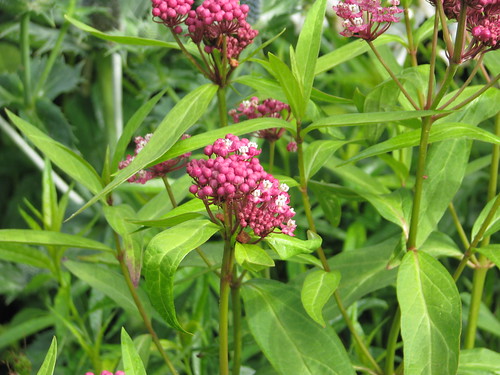
There are lots of exciting species of Asclepias in the U.S.A. This is one of the most common and deserves to be more widely grown over here. The flowers, in contrasting pale and dark pink resemble those of a Hoya (to which it is related) and are worth a close look. Leafy, clump-forming herbaceous perennials with reddish stems to 2ft. Any soil, but heavy and damp soils in sun are especially favoured.
3L pots ~ £8
Monday, 8 June 2009
Weigela coraeensis
Sunday, 7 June 2009
Buying your plants
On line I can accept payments by Paypal, international bank transfer, cheque (with a not-to exceed amount written across the lines in case not everything you order is available, and payable to me, Steve Law) with card details of course. At the nursery, sadly, I cannot take card payments.
PLEASE PROVIDE A CONTACT NUMBER WHEN YOU ORDER. I NEED IT FOR THE CARRIERS IN CASE SOMETHING GOES WRONG.
I recommend phoning ahead if you want me to put things by for you for when you arrive.
Please enquire about availability before ordering. Some plants are only available in very small numbers.
Although I am more than happy to discuss your choices and give advice, I would strongly recommend having a good look at the information and photos here on the website before coming, and making a list of the things that interest you.
Post and packaging
Within the UK (excluding Scottish Highlands and islands, Northern Ireland and other UK islands) delivery charges are as follows:
|
p&p |
Order
value between - |
|
|
£7.00 |
£3.00 |
£10.00 |
|
£15.00 |
£10.01 |
£105.00 |
|
£30.00 |
£105.01 |
£140.00 |
|
£60.00 |
£140.01 |
and
above |
Deliveries to other parts of the EU are perfectly possible but we will need to agree the p&p. Please contact me before ordering.
I am entirely open to other options concerning the best way to get your plants to you, and if you live locally I might well be able to deliver in person. Please feel free to contact me.
Time of dispatch
Please note - as yet we are far from Amazonian in our speed of dispatch. I have no staff and still have a day job so please allow three weeks or so from time of ordering to receiving your plant. If you need your plants at a specific time - if they are a gift for example, or you are planning to be away, please let me know.
Unlike many nurseries, I am prepared to send plants out at any time of year. Plants in full growth in summer often travel remarkably well if they are properly packed in a large box and don't overheat. Foliage and even flowers spring back and plants establish quickly given the correct planting and after-care. Be aware that some plants though have very brittle stems (members of the poppy family for instance) and might suffer more than others.
On the other hand, buying plants in the winter (the traditional time to sell plants) can be something of a lucky dip, especially with plants that go completely underground. We've all had the experience of buying an apparently lifeless pot in winter and in the spring discovering it is indeed completely lifeless.
Generally I prefer to send plants out as they begin growth in the spring or are dying back in the late summer-autumn period.
Packages are generally sent out via the Royal Mail, who have not let me down yet, and generally toward the beginning of the week to avoid them hanging around over the weekend. Please let me know if you want the plants to arrive by or at a particular time.
On arrival
On arrival, it is best to unpack your plants immediately and give them some water, especially in hot weather. I sometimes find it best not to plant them immediately but to stand them somewhere sheltered from excess heat, cold and wind for at least a day or two to adjust. If conditions are not right for planting immediately or if it is inconvenient it may make sense to pot plants on temporarily until you get around to them, rather than leave them in the containers they arrived in.
Plant sizes
Some nurseries I know send out what are little more than seedlings or rooted cuttings among their consignments which, realistically, need growing on in the nursery for another season before they can be expected to survive in the open. I am happy to send out immature plants at reduced prices to customers who enjoy growing things on but as a rule I send only mature plants or strong young plants that can go into the ground more-or-less immediately.
Mistakes and problems
For my part I will endeavour to make sure that the plants I send are strong and healthy and correctly identified. I cannot guarantee that plants will have no evidence of 'wildlife' on them at all but in the unlikely event that a plant is not the one you ordered, has been seriously damaged in transit, is infested, dessicated, rotted off or otherwise moribund, do not hesitate to contact me as soon as possible to arrange a replacement or refund.
With consignments sent abroad, I can't accept responsibility if the customs men decide to get whimsical with your package. I'll fill out any paperwork required but after that it's out of my hands. They seem to be a law unto themselves. That said, I've had no problems yet, touch wood...
Availability
Some varieties are available only in small quantities so contact me first to avoid being disappointed. If you see anything that especially interests you in the Blog or in the Gallery Flickr photoset that is not listed please don't hesitate to ask about future availability. I might not be able to reserve plants individually long term but depending on how busy I get, I may be able to alert you if something you've asked about becomes available.
Many thanks
Steve
Monday, 1 June 2009
Peat
'Not this again' I hear you cry. Yes this again. People still seem very suspicious, not to say downright hostile when they see I don't use peat. 'Don't you know how much peat the Irish power stations burn every day?' they say. Well no, not precisely, but I can imagine. I am well aware what a futile gesture this may seem but then, I feel I can afford to make it because I think peat free composts are actually better.
Aha. You weren't expecting that were you?
I got back from a couple of days away recently (buying stock plants in Hampshire) to find inevitably some plants sitting in completely dried-out compost. It ocurred to me as I hosed them down, sipping my latte, that in the past, when I used peat-based compost like everyone else I'd have been spending this time soaking them in a bucket of water and they'd have been sadly floating there and I'd have been stomping about (tired and scuzzy from travelling) waiting for them to take up the water. I know some modern composts have 'wetting agents' (aka soap) but really, why bother when you could be just standing there, hosing them down with a cup of coffee in your hand, watching the bats as the pots quickly and naturally, absorb the water?
Secondly, and I have absolutely no proper evidence for this claim, only personal experience (and I am enough of a scientist to know how much that counts for) I have not seen a vine weevil here since I began (touches wood for good measure). It has long been said that vine weevil like peat-based composts and loam-based (John Innes) composts were suggested as a partial solution. My feeling at the moment is that they don't really like peat-free composts either, despite the similar texture. Interesting.
Beyond this, I've not noticed that peat-free composts are less productive than peat-based. Maybe it's a matter of a few percent in bulk or numbers or time (but then I don't lose plants because the compost is unwettable). A few percentage points no doubt matter hugely to big producers (for whom vast consistent supplies of peat were a major advantage of course) but are to me undetectable.
Furthermore, besides its acidity, peat is more or less chemically inert. Any nutrients have to be added. Growing plants in peat is therefore not that different from growing plants hydroponically, and one would not expect plants grown hydroponically to do well when transfered to ordinary garden soils.
And yes, from an environmental point of view, and whatever the Irish might be doing, why import vast quantities of natural habitat when there's all this waste product available?
Peat-free composts do vary in quality, I know. I've tried a few in my time and the one I use is the New Horizon Organic and Peat Free multipurpose (no they're not paying me to say this) which used to be a bit patchy and had little needles in it, like raspberry canes or cacti had been composted in it but which is now of consistent fine quality. I mix this with a John Innes loam-based compost (number 2 or 3, which I know still include some peat) more or less 50:50 which I feel gives a better texture and makes the pots a bit heavier so the plants don't blow over so easily if they dry out (and which is recommended by Pippa Greenwood I believe). I also add sand or grit for plants that like a more drained compost and blood-fish-and-bone if the plants need a bit of extra feeding.
I realise this system would be difficult to implement on an industrial scale but for a small nursery, well, I find the results more than satisfactory.
Aha. You weren't expecting that were you?
I got back from a couple of days away recently (buying stock plants in Hampshire) to find inevitably some plants sitting in completely dried-out compost. It ocurred to me as I hosed them down, sipping my latte, that in the past, when I used peat-based compost like everyone else I'd have been spending this time soaking them in a bucket of water and they'd have been sadly floating there and I'd have been stomping about (tired and scuzzy from travelling) waiting for them to take up the water. I know some modern composts have 'wetting agents' (aka soap) but really, why bother when you could be just standing there, hosing them down with a cup of coffee in your hand, watching the bats as the pots quickly and naturally, absorb the water?
Secondly, and I have absolutely no proper evidence for this claim, only personal experience (and I am enough of a scientist to know how much that counts for) I have not seen a vine weevil here since I began (touches wood for good measure). It has long been said that vine weevil like peat-based composts and loam-based (John Innes) composts were suggested as a partial solution. My feeling at the moment is that they don't really like peat-free composts either, despite the similar texture. Interesting.
Beyond this, I've not noticed that peat-free composts are less productive than peat-based. Maybe it's a matter of a few percent in bulk or numbers or time (but then I don't lose plants because the compost is unwettable). A few percentage points no doubt matter hugely to big producers (for whom vast consistent supplies of peat were a major advantage of course) but are to me undetectable.
Furthermore, besides its acidity, peat is more or less chemically inert. Any nutrients have to be added. Growing plants in peat is therefore not that different from growing plants hydroponically, and one would not expect plants grown hydroponically to do well when transfered to ordinary garden soils.
And yes, from an environmental point of view, and whatever the Irish might be doing, why import vast quantities of natural habitat when there's all this waste product available?
Peat-free composts do vary in quality, I know. I've tried a few in my time and the one I use is the New Horizon Organic and Peat Free multipurpose (no they're not paying me to say this) which used to be a bit patchy and had little needles in it, like raspberry canes or cacti had been composted in it but which is now of consistent fine quality. I mix this with a John Innes loam-based compost (number 2 or 3, which I know still include some peat) more or less 50:50 which I feel gives a better texture and makes the pots a bit heavier so the plants don't blow over so easily if they dry out (and which is recommended by Pippa Greenwood I believe). I also add sand or grit for plants that like a more drained compost and blood-fish-and-bone if the plants need a bit of extra feeding.
I realise this system would be difficult to implement on an industrial scale but for a small nursery, well, I find the results more than satisfactory.
Sunday, 31 May 2009
So I said last week to Emma, looking at our garden, 'You know, I believe I'm actually finally quite a good gardener.' She looked aghast at me. She knows I live and breed plants. She knows I read everything I can find on plants, that I have a gargantuan database that started out as a little notebook wish-list of plants more than twenty-five years ago and which now has 12000 entries. She looks about at what I've created here in what is really a very modest suburban garden and she thinks I'm being laughably self-effacing. But I'm not. It's taken this long to get me to the stage where I can look about and think 'I actually feel like I know what I'm doing.' I can't tell you how satisfying that is. I've moved on average once a year since I left home including a year in Australia and several moves to university towns to study ecology. Gardens need a permanent home. It's not a good combination. So I've been through my Gargantuan Plant List and the RHS Plantfinder and noted all the things that I think are worth growing that don't seem to be available locally, or at all in the UK, and I'm going about the business of getting hold of the seeds and stock plants and setting up my very own nursery.
Wednesday, 27 May 2009
Another gardening blog...
I'm going to be completely honest about this. What I actually wanted was website to advertise my nursery down here in Sussex but have you seen how much getting one of those up and running is likely to set me back?
Then I had this idea that it would be a great if someone (not me, I know nothing about website design) would set up a website like Flickr or Lulu where you could make your own web pages for a perhaps nominal fee, in my case to run as a catalogue with lots of nice pictures of the plants I sell and some sort of checkout system. Apparently no such thing exists.
So running this blog as a catalogue looks to be the next best option.
Anyway, I am one of those unfortunates that thinks that his opinions and observations are likely to be of interest to others, so I'll be taking the opportunity to fill some column inches in the process.
Then I had this idea that it would be a great if someone (not me, I know nothing about website design) would set up a website like Flickr or Lulu where you could make your own web pages for a perhaps nominal fee, in my case to run as a catalogue with lots of nice pictures of the plants I sell and some sort of checkout system. Apparently no such thing exists.
So running this blog as a catalogue looks to be the next best option.
Anyway, I am one of those unfortunates that thinks that his opinions and observations are likely to be of interest to others, so I'll be taking the opportunity to fill some column inches in the process.
Subscribe to:
Posts (Atom)



